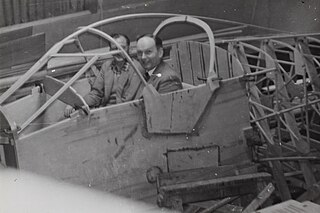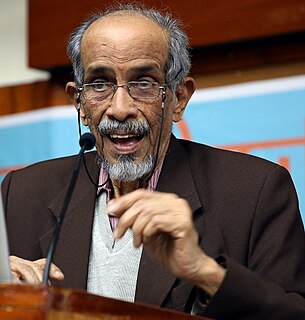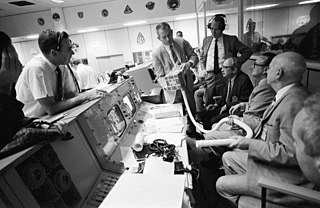Related Research Articles

Aeronautics is the science or art involved with the study, design, and manufacturing of air flight–capable machines, and the techniques of operating aircraft and rockets within the atmosphere. The British Royal Aeronautical Society identifies the aspects of "aeronautical Art, Science and Engineering" and "The profession of Aeronautics ."

The National Advisory Committee for Aeronautics (NACA) was a United States federal agency founded on March 3, 1915, to undertake, promote, and institutionalize aeronautical research. On October 1, 1958, the agency was dissolved and its assets and personnel were transferred to the newly created National Aeronautics and Space Administration (NASA). NACA is an initialism, i.e., pronounced as individual letters, rather than as a whole word.
Simon "Si" Ramo was an American engineer, businessman, and author. He led development of microwave and missile technology and is sometimes known as the father of the intercontinental ballistic missile (ICBM). He also developed General Electric's electron microscope. He played prominent roles in the formation of two Fortune 500 companies, Ramo-Wooldridge and Bunker-Ramo.

St. Andrew's College is an Anglican high school for boys located in Makhanda, Eastern Cape province of South Africa. It was founded in 1855 by the Right Reverend John Armstrong, the first Bishop of Grahamstown. It is a semi boarding school, with a number of day boys. St. Andrew's College caters to 480 pupils from around the globe. The school is also a member of the G20 Schools group and closely associated with its brother school, St. Andrew's Preparatory School, and its sister school the Diocesan School for Girls.

Henry K. Millicer, AM born Henryk Kazimierz Milicer, was a Polish-Australian aircraft designer and pilot.

Roddam Narasimha was an Indian aerospace scientist and fluid dynamicist. He was a professor of Aerospace Engineering at the Indian Institute of Science (1962–1999), director of the National Aerospace Laboratories (1984–1993) and the chairman of the Engineering Mechanics Unit at Jawaharlal Nehru Centre for Advanced Scientific Research. He was the DST Year-of-Science Chair Professor at JNCASR and concurrently held the Pratt & Whitney Chair in Science and Engineering at the University of Hyderabad. Narasimha was awarded the Padma Vibhushan, India's second-highest civilian award, in 2013.

Guy Antony Jameson, FRS, FREng is Professor of Engineering in the Department of Aeronautics & Astronautics at Stanford University. Jameson is known for his pioneering work in the field of computational fluid dynamics. He has published more than 300 scientific papers in a wide range of areas including computational fluid dynamics, aerodynamics, and control theory.
Clark Blanchard Millikan was a distinguished professor of aeronautics at the California Institute of Technology (Caltech), and a founding member of the National Academy of Engineering.

Daniel R. Mulville is an American engineer who served briefly as Acting Administrator of NASA in 2001.
Alfred John Sutton Pippard MBE FRS was a British civil engineer and academic. Pippard was the son of a carpenter and joiner and spent much of his early life helping his father on construction sites. Initially supposed to follow his father into the family business, Pippard instead decided to study for a bachelor's degree in civil engineering at the University of Bristol, supporting himself with an Exhibition award. Pippard worked for a Bristol based consulting engineer and for the Pontypridd and Rhondda Valley Joint Water Board in his early career. He also completed his master's degree during this period.

Embry–Riddle Aeronautical University, Prescott is a residential campus of Embry-Riddle Aeronautical University in Prescott, Arizona. The university offers bachelor, master's, and PhD degree programs in arts, sciences, aviation, business, engineering, and security & intelligence. The Prescott campus also offers a master's degree in Safety Science, Security & Intelligence, and Cyber Intelligence & Security.

Niranjan Krishna Naik is an Indian Aerospace Engineer and Professor Emeritus at Indian Institute of Technology Bombay,Mumbai. He is known for his research work on thermomechanical behavior of textile composites and ballistic impact, low velocity impact, fatigue and fracture of composites. His special interest is also on science and technology of aircraft production. Major awards and recognitions conferred to him are: Fellowship of the National Academy of Sciences, India (2004); Fellowship of the Indian National Academy of Engineering (2005); Professor H. H. Mathur Award for "Excellence in Research in Applied Sciences 2006" by IIT Bombay; "Excellence in Aerospace Education Award 2008" by the Aeronautical Society of India; Aerospace Engineering Division Gold Medal of the Institution of Engineers (India) for the year 1992-93 for his research on polymer matrix composites and "Shri Hotchand M. Lala and Shrimati Jamuna H. Lala Excellence in Teaching Award, 2013" by IIT Bombay.
Korea Aerospace University is a private university in Goyang, Gyeonggi, South Korea.
Eric Harold Mansfield FRS FREng was an aeronautical engineer who won the Royal Medal in 1994, "for his many fundamental and analytical contributions to our knowledge of advanced aeronautical structures, and more recently to the biological sciences."

Aerospace engineering is the primary field of engineering concerned with the development of aircraft and spacecraft. It has two major and overlapping branches: aeronautical engineering and astronautical engineering. Avionics engineering is similar, but deals with the electronics side of aerospace engineering.
Parks College of Engineering, Aviation and Technology is a college within Saint Louis University.
William Rees Sears was a notable aeronautical engineer and educator.
Seung Jo Kim is a South Korean aerospace engineer. He has been the current President of Korea Aerospace Research Institute (KARI) since June 2011, where the most of the national aerospace systems like aircraft, satellites and rockets are developed. During his tenure, Kim led the development of smart Unmanned aerial vehicle (UAV), the launch of KOMPSAT-3, KOMPSAT-5, STSat-3 and the first Korean space launch vehicle, Naro-1. Before becoming president of KARI, Kim had been a professor of the Engineering College at Seoul National University since 1986. He chaired the KSAS in 2009, the KSCM from 2005 to 2006, and the KSIAM from 2004 to 2008. He was also head of the New Aerospace Technology Research Institute from 2001 to 2003. Kim has been a fellow of the American Institute of Aeronautics and Astronautics (AIAA) since 2010 and the Institute of Physics since 2004.

Richard Karl Saxer was a lieutenant general in the United States Air Force who served as director, Defense Nuclear Agency in Washington, D.C.
Achille Messac is the Dean of the College of Engineering, Architecture and Computer Sciences at Howard University. He has previously served as Professor of Aerospace Engineering Mississippi State University. He was elected a Fellow of the American Association for the Advancement of Science in 2019.
References
- ↑ Poland 2008, p. 470.
- ↑ Obituary of Kim Bailie in the Sunday Times
- ↑ Ramsden, Mike. "Andrean Foundation". oldandrean.co.za. Retrieved 14 March 2016.
- Poland, Marguerite (2008). The Boy in You: A Biography of St. Andrew's College, 1855-2005. Fernwood Press. ISBN 978-1-874950-86-8.